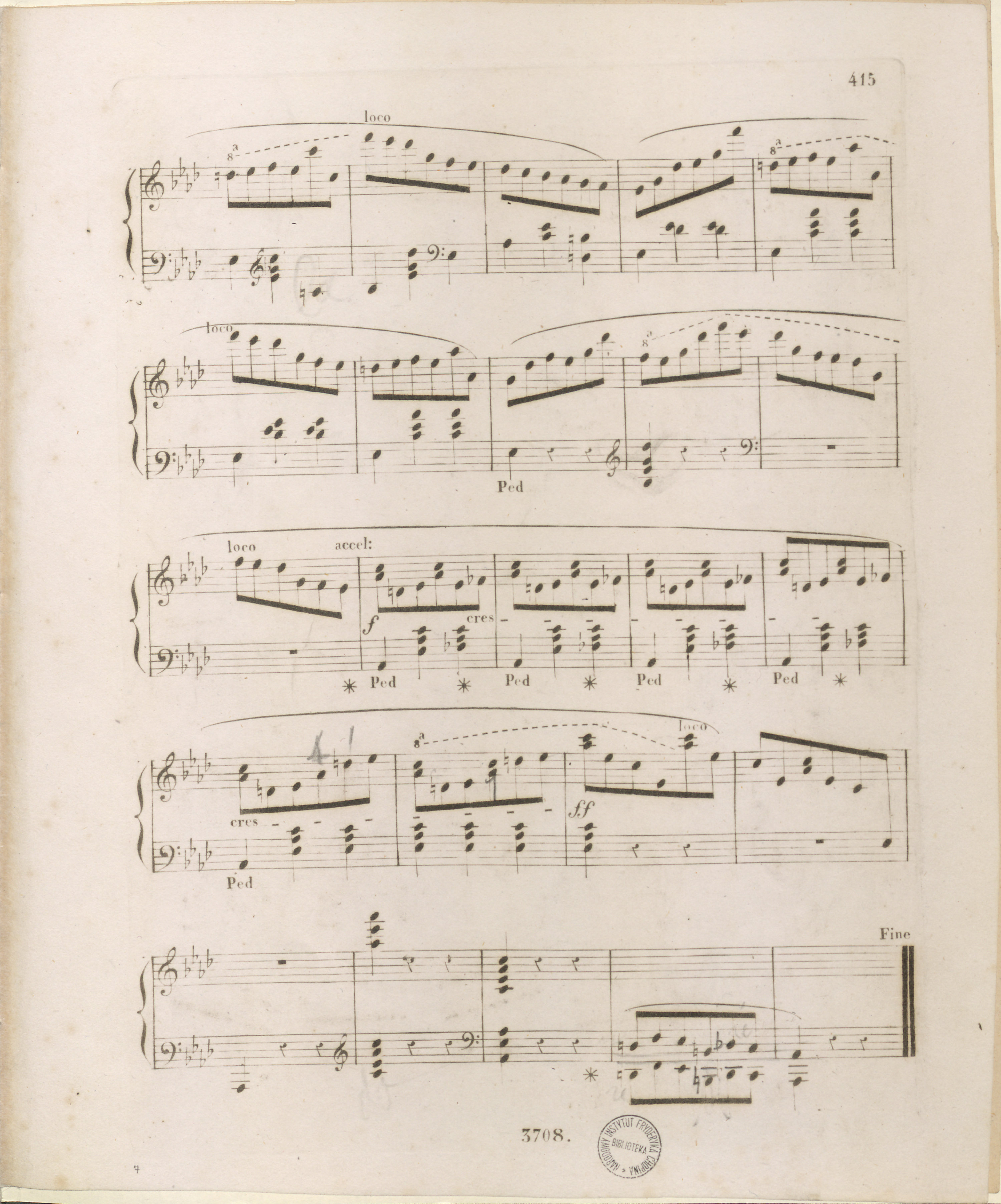



This bar, constituting a pianistically homogeneous passage with the next one, must be considered in a broader context. The final character, fast tempo and virtuoso momentum of this fragment advocate for a regular construction of the figuration. In this situation, the differentiation of bars 281 and 282 (a 1 in bar 281 but a
1 in bar 281 but a 2-c3 in bar 282) present in FE and GE1 seems to be problematic, particularly due to the fact that the sound difference between this version and the more schematic version of EE (thirds in both bars) is very marginal. The engraver of FE could have simply just overlooked the c2 note in bar 281, particularly if there were deletions or other corrections in [A] and Chopin completed it only at the time of preparing the base text to EE.
2-c3 in bar 282) present in FE and GE1 seems to be problematic, particularly due to the fact that the sound difference between this version and the more schematic version of EE (thirds in both bars) is very marginal. The engraver of FE could have simply just overlooked the c2 note in bar 281, particularly if there were deletions or other corrections in [A] and Chopin completed it only at the time of preparing the base text to EE.
On the other hand, it is the version with single a 1 in bar 281 that is most certain, as far as the sources are concerned – printed in FE0 on the basis of [A], left uncorrected by Chopin in FEG (→GE) and in the proofreading of FE, despite the fact that at the time of adding dynamic and pedalling marks, the composer must have looked at the bar a few times. The corrections are also absent in the pupils' copies, in particular in FED, including practical hints two bars later. The alternative version of EE (with a third in this place) may be a result of a mistake – thirds at this pitch appear in EE in neighbouring bars 13 times, including erroneously at the beginning of bar 284. One cannot also exclude a homogenising revision of bars 281-282.
1 in bar 281 that is most certain, as far as the sources are concerned – printed in FE0 on the basis of [A], left uncorrected by Chopin in FEG (→GE) and in the proofreading of FE, despite the fact that at the time of adding dynamic and pedalling marks, the composer must have looked at the bar a few times. The corrections are also absent in the pupils' copies, in particular in FED, including practical hints two bars later. The alternative version of EE (with a third in this place) may be a result of a mistake – thirds at this pitch appear in EE in neighbouring bars 13 times, including erroneously at the beginning of bar 284. One cannot also exclude a homogenising revision of bars 281-282.
Such a homogenising revision, although going in the opposite direction, was certainly performed in GE2 (→GE3), in which in both bars 281-282 on the 4th quaver there is a single a 1 (a
1 (a 2). However, it cannot be entirely excluded that the reviser guessed Chopin's intention correctly and that it is exactly the third in bar 282 that is an error (cf. bar 284). A possibility that Chopin did not notice this error neither in in FEG, in the the proofreading of FE and in the base text to EE nor in the pupils' copies seems to be, however, marginal.
2). However, it cannot be entirely excluded that the reviser guessed Chopin's intention correctly and that it is exactly the third in bar 282 that is an error (cf. bar 284). A possibility that Chopin did not notice this error neither in in FEG, in the the proofreading of FE and in the base text to EE nor in the pupils' copies seems to be, however, marginal.
Repeated thirds may be considered as elements constituting a rhythmic structure of a higher order. Particular versions result in the following rhythmic schemes (the examples include bars 277-284, one bar in 2/2 corresponds two in 3/4):
FE and GE1 (a 1 in bar 281 and a
1 in bar 281 and a 2-c3 in bar 282)
2-c3 in bar 282)
EE (a 1-c2 in bar 281 and a
1-c2 in bar 281 and a 2-c3 in bar 282)
2-c3 in bar 282)
GE2 and GE3 (a 1 in bar 281 and a
1 in bar 281 and a 2 in bar 282)
2 in bar 282)
According to us, all three schemes are satisfactory, yet the first of them, emphasising the beginning of the final tonic passage in bar 281, may be considered as structurally the richest.
Compare the passage in the sources »
category imprint: Interpretations within context; Differences between sources
issues: EE revisions, Errors in FE, Authentic corrections of EE
notation: Pitch




